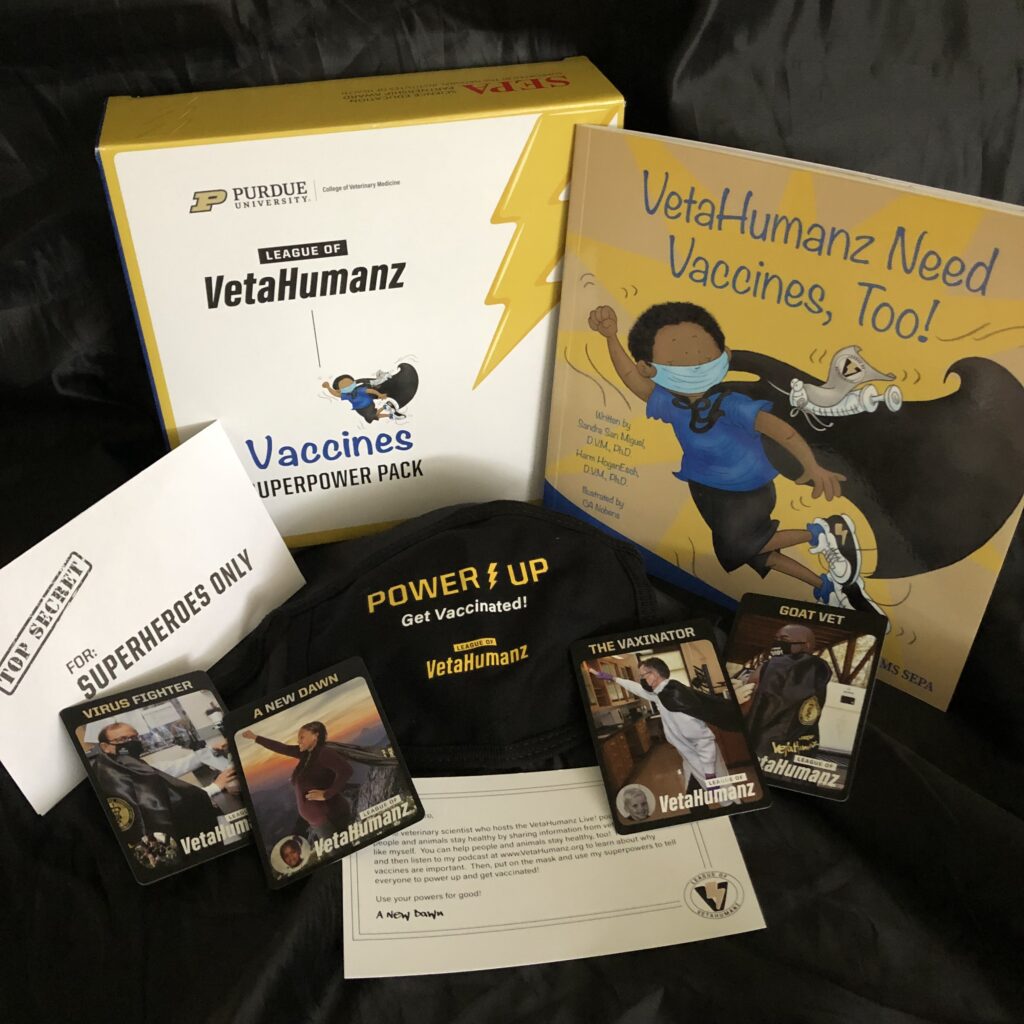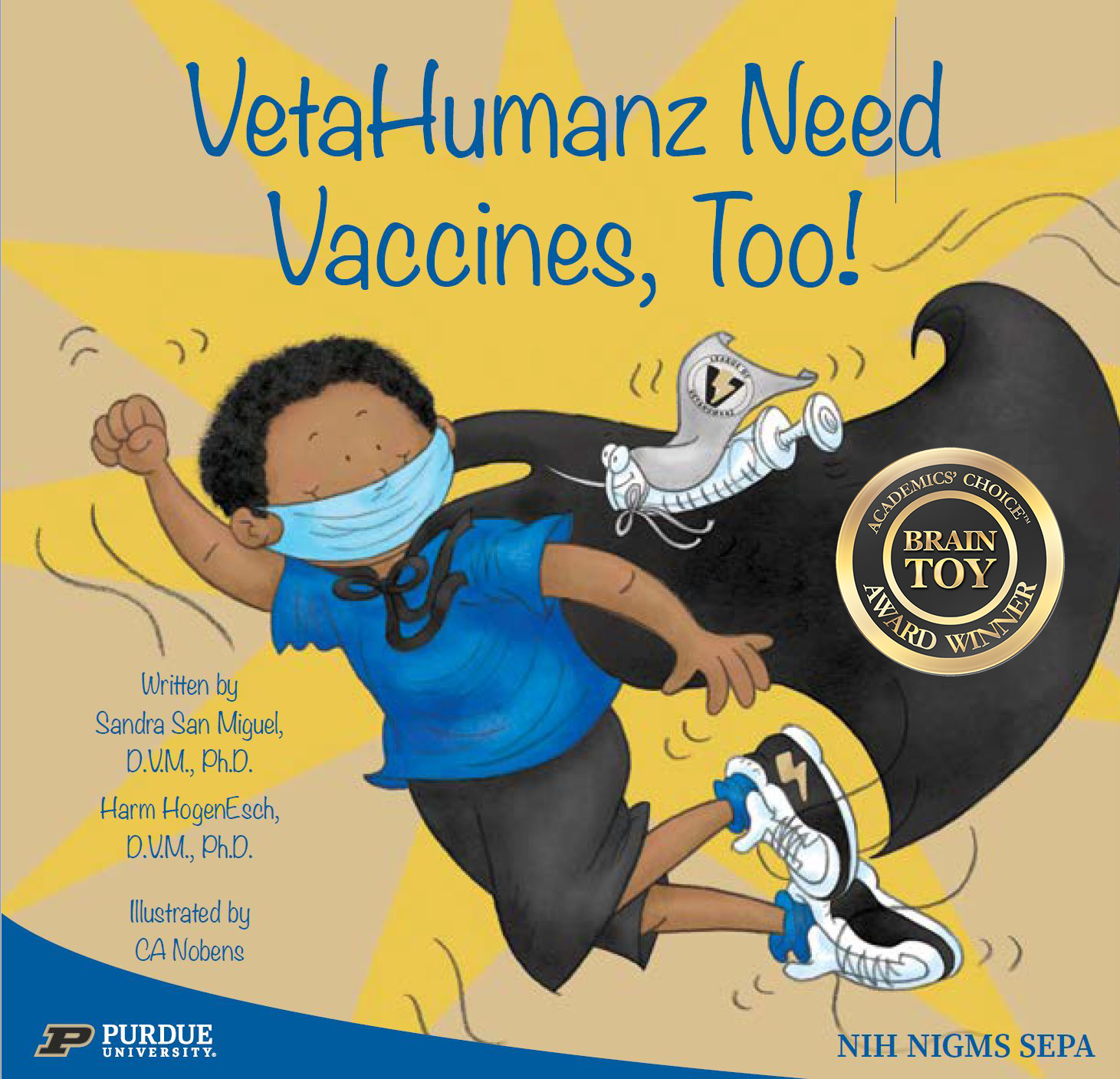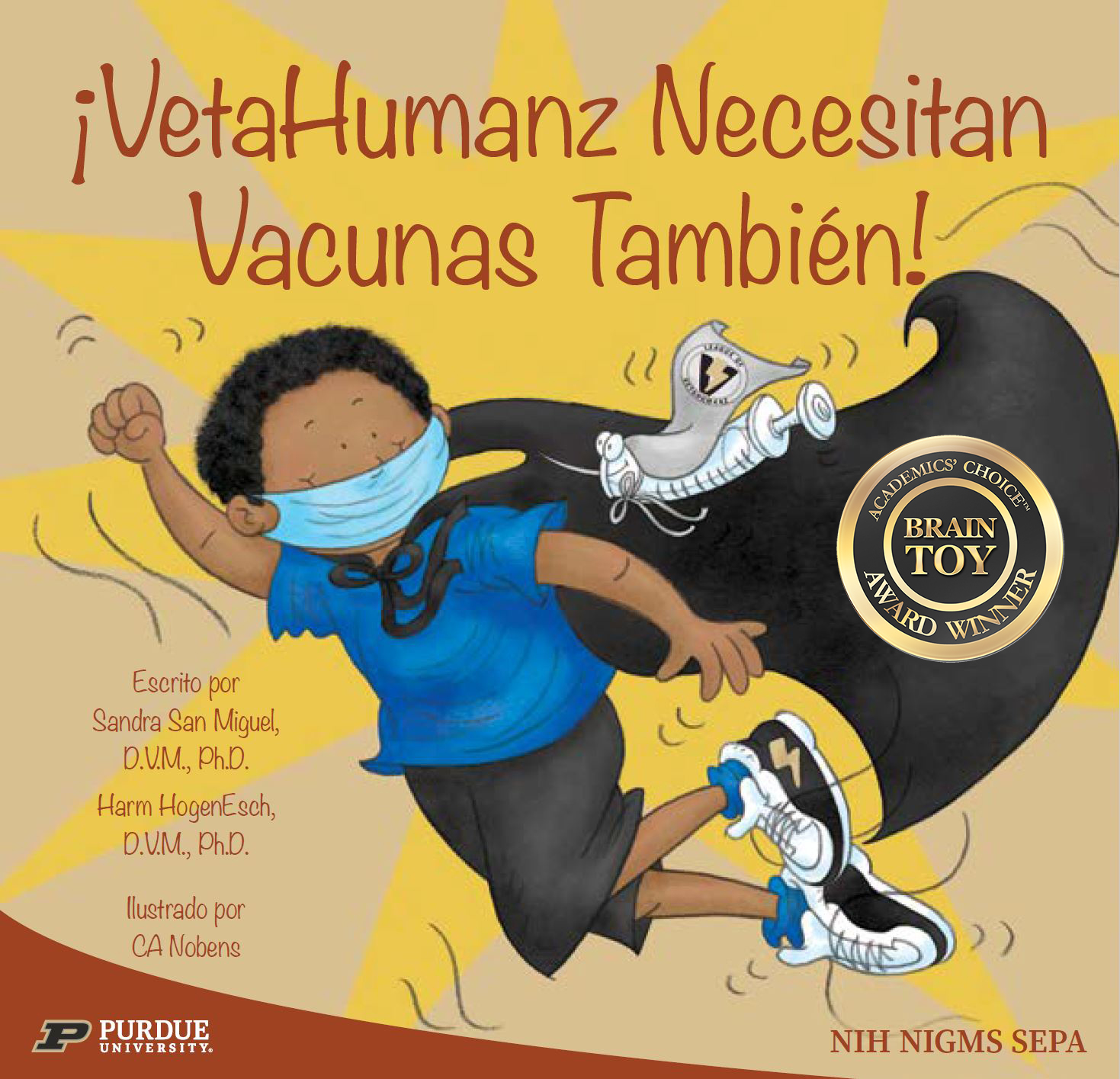Vaccines SuperPower Pack
SuperPower Packs are self-guided, educational experiences for kids lacking access to in-person veterinary role models. Each SuperPower Pack contains an activity to help kids engage in veterinary careers by taking on the persona of a veterinary superhero. The Vaccines SuperPower Pack, helps kids learn about how vaccines give people and their animals superpowers to fight germs. Thanks to support from NIH and our sponsors, we have given thousands of SuperPower Packs to under-resourced children who are participating in our programs.

2022 Academic’s Choice Award Winner
“Complete with a card game, mask, and book, the Vaccines SuperPower Pack has been an awesome way to teach my curious kids about what vaccines are in a way they’d understand. They were little when the pandemic began and couldn’t quite comprehend everything a couple of years ago, but now that they’re a little bit older they have more questions. Not only do they understand themselves now how vaccines work in our bodies and the role of masks, but they are able to verbalize to their friends and each other about the subject too. Thanks Purdue University!”
The Unboxing
VetaHumanz Need Vaccines, Too! The Book
VetaHumanz Need Vaccines, Too! is a book that helps kids and adults learn about how vaccines give people and their animals superpowers to fight germs. Click on the cover to download your copy now!
Ages 6 and up
VetaHumanz Need Vaccines Too! The Academic Standards
3https://www.nextgenscience.org/
https://www.cdc.gov/healthyschools/sher/standards/index.htm
Next Generation Science Standards
K-2-ETS1-1 Engineering Design
Ask questions, make observations, and gather information about a situation people want to change to define a simple problem that can be solved through the development of a new or improved object or tool.
K-ESS3-1 Earth and Human Activity
Use a model to represent the relationship between the needs of different plants and animals (including humans) and the places they live.
3-5-ETS1-2 Engineering Design
Generate and compare multiple possible solutions to a problem based on how well each is likely to meet the criteria and constraints of the problem.
National Health Education Standards
STANDARD 1: Students will comprehend concepts related to health promotion and disease prevention to enhance health.
PreK-2nd
- 1.2.1: Identify that healthy behaviors impact personal health
- 1.2.3: Describe ways to prevent communicable diseases.
- 1.2.5: Describe why it is important to seek health care.
Grade 3-5
- 1.5.1: Describe the relationship between healthy behaviors and personal health.
- 1.5.3: Describe ways in which safe and healthy school and community environments can promote personal health.
- 1.5.4: Describe ways to prevent common childhood injuries and health problems.
- 1.5.5: Describe when it is important to seek health care.
STANDARD 2: Students will analyze the influence of family, peers, culture, media, technology, and other factors on health behaviors.
PreK-2nd
- 2.2.1: Identify how the family influences personal health practices and behaviors.
- 2.2.2: Identify what the school can do to support personal health practices and behaviors.
Grades 3-5
- 2.5.1: Describe how family influences personal health practices and behaviors.
- 2.5.2: Identify the influence of culture on health practices and behaviors.
- 2.5.3: Identify how peers can influence healthy and unhealthy behaviors.
- 2.5.4: Describe how the school and community can support personal health practices and behaviors.
- 2.5.5: Explain how the media influences thoughts, feelings, and health behaviors.
- 2.5.6: Describe ways that technology can influence personal health.
STANDARD 3: Students will demonstrate the ability to access valid information, products, and services to enhance health.
PreK-2nd
- 3.2.1: Identify trusted adults and professionals who can help promote health.
- 3.2.2: Identify ways to locate school and community health helpers.
Grades 3-5
- 3.5.1: Identify characteristics of valid health information, products, and services.
- 3.5.2: Locate resources from home, school, and community that provide valid health information.
STANDARD 4: Students will demonstrate the ability to use interpersonal communication skills to enhance health and avoid or reduce health risks.
PreK-2nd
- 4.2.2: Demonstrate listening skills to enhance health.
Grades 3-5
- 4.5.1: Demonstrate effective verbal and nonverbal communication skills to enhance health.
- 4.5.4: Demonstrate how to ask for assistance to enhance personal health.
STANDARD 5: Students will demonstrate the ability to use decision-making skills to enhance health.
PreK-2nd
- 5.2.1: Identify situations when a health-related decision is needed.
Grades 3-5
- 5.5.1: Identify health-related situations that might require a thoughtful decision.
- 5.5.3: List healthy options to health-related issues or problems.
- 5.5.4: Predict the potential outcomes of each option when making a health-related decision.
- 5.5.5: Choose a healthy option when making a decision.
- 5.5.6: Describe the outcomes of a health-related decision.
STANDARD 6: Students will demonstrate the ability to use goal-setting skills to enhance health.
PreK-2nd
- 6.2.1: Identify a short-term personal health goal and take action toward achieving the goal.
- 6.2.2: Identify who can help when assistance is needed to achieve a personal health goal.
Grades 3-5
- 6.5.2: Identify resources to assist in achieving a personal health goal.
STANDARD 7: Students will demonstrate the ability to practice health-enhancing behaviors and avoid or reduce health risks.
PreK-2nd
- 7.2.1: Demonstrate healthy practices and behaviors to maintain or improve personal health.
- 7.2.2: Demonstrate behaviors that avoid or reduce health risks.
Grades 3-5
- 7.5.1: Identify responsible personal health behaviors.
- 7.5.2: Demonstrate a variety of healthy practices and behaviors to maintain or improve personal health.
- 7.5.3: Demonstrate a variety of behaviors to avoid or reduce health risks.
STANDARD 8: Students will demonstrate the ability to advocate for personal, family, and community health.
PreK-2nd
- 8.2.1: Make requests to promote personal health.
- 8.2.2: Encourage peers to make positive health choices.
Grades 3-5
- 8.5.1: Express opinions and give accurate information about health issues.
- 8.5.2: Encourage others to make positive health choices.
Common Core Standards – English Language Arts
- ELA-LITERACY.CCRA.R.1: Read closely to determine what the text says explicitly and to make logical inferences from it; cite specific textual evidence when writing or speaking to support conclusions drawn from the text.
Grades K-2
- ELA-LITERACY.RI.K.1: With prompting and support, ask and answer questions about key details in a text.
- ELA-LITERACY.RI.1.1: Ask and answer questions about key details in a text.
- ELA-LITERACY.RI.2.1: Ask and answer such questions as who, what, where, when, why, and how to demonstrate understanding of key details in a text.
Grades 3-5
- ELA-LITERACY.RI.3.1: Ask and answer questions to demonstrate understanding of a text, referring explicitly to the text as the basis for the answers.
- ELA-LITERACY.RI.4.1: Refer to details and examples in a text when explaining what the text says explicitly and when drawing inferences from the text.
This program is supported by the Science Education Partnership Award (SEPA) program of the National Institute of General Medical Sciences (NIGMS) of the National Institutes of Health (NIH). Its contents are solely the responsibility of the authors and do not necessarily represent the official views of the NIH.





